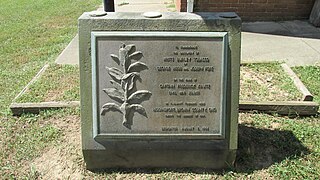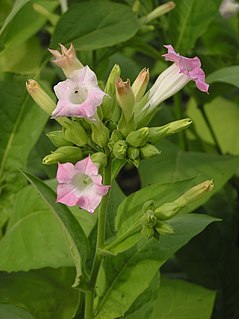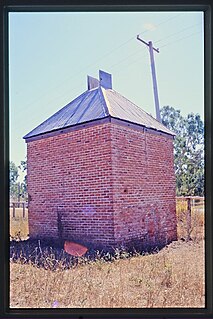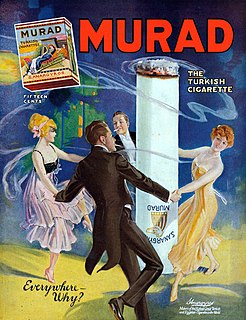
Tobacco is the common name of several plants in the genus Nicotiana of the family Solanaceae, and the general term for any product prepared from the cured leaves of these plants. More than 70 species of tobacco are known, but the chief commercial crop is N. tabacum. The more potent variant N. rustica is also used in some countries.

Burley tobacco is a light air-cured tobacco used primarily for cigarette production. In the United States it is produced in an eight-state belt with approximately 70% produced in Kentucky. Tennessee produces approximately 20%, with smaller amounts produced in Indiana, North Carolina, Missouri, Ohio, Virginia, Maryland, Pennsylvania and West Virginia. Burley tobacco is produced in many other countries, with major production in Brazil, Malawi and Argentina.
Cavendish Tobacco refers to tobacco that has been heat treated with fire or steam and then subjected to heavy pressure in order to produce a sweet taste with a moist texture. American, Dutch, and Danish varieties involve the addition of flavorings; while British Cavendish, commonly known as unsweetened or unflavored Cavendish brings out the natural sugars in the tobacco through pressure applied during the preparation process. Cavendish tobacco is named after Sir Thomas Cavendish.

Nicotiana tabacum, or cultivated tobacco, is an annually grown herbaceous plant. It is found in cultivation, where it is the most commonly grown of all plants in the genus Nicotiana, and its leaves are commercially grown in many countries to be processed into tobacco. It grows to heights between 1 and 2 meters. Research is ongoing into its ancestry among wild Nicotiana species, but it is believed to be a hybrid of Nicotiana sylvestris, Nicotiana tomentosiformis, and possibly Nicotiana otophora.
The tobacco barn, a type of functionally classified barn found in the USA, was once an essential ingredient in the process of air-curing tobacco. In the 21st century they are fast disappearing from the landscape in places where they were once ubiquitous. The barns have declined with the tobacco industry in general, and U.S. States such as Maryland actively discourage tobacco farming. When the US tobacco industry was at its height, tobacco barns were found everywhere the crop was grown. Tobacco barns were as unique as each area in which they were erected, and there is no one design that can be described as a tobacco barn.

Turkish tobacco, or Oriental tobacco, is a highly aromatic, small-leafed variety of tobacco which is sun-cured. Turkish tobacco plants usually have a greater number and smaller size leaves. These differences can be attributed to climate, soil, cultivation and treatment methods. Historically, it was cultivated primarily in Thrace and Macedonia, now divided among Bulgaria, Greece, North Macedonia and Turkey, but it is now also grown on the Black Sea coast of Turkey, in Egypt, in South Africa and elsewhere.

This article contains a list of tobacco cultivars and varieties, as well as unique preparations of the tobacco leaf involving particular methods of processing the plant.

The cultivation of tobacco usually takes place annually. The tobacco is germinated in cold frames or hotbeds and then transplanted to the field until it matures. It is grown in warm climates with rich, well-drained soil. About 4.2 million hectares of tobacco were under cultivation worldwide in 2000, yielding over seven million tonnes of tobacco.

In nearly all instances where tobacco is to be used for smoking or chewing, it is necessary to cure the tobacco directly after it's harvested. Tobacco curing is also known as color curing, because tobacco leaves are cured with the intention of changing their color and reducing their chlorophyll content.
Tutunski kombinat Prilep is a tobacco company headquartered in Prilep, North Macedonia. The company mainly deals with the purchasing and selling of high quality oriental tobacco ; its operations also include the production of cigarettes. The Prilep region is known for its production of quality oriental tobacco. Tobacco tradition in Prilep goes back to 1873 when R.O.T built the first warehouse for purchasing and processing tobacco. In 1930 the Croatian scientist Rudolf Gornik introduced the first varieties of famous oriental type Prilep and heralded the beginning of a golden tobacco era in Prilep. The then Government of Yugoslavia issued a special resolution in 1949 which established a state-owned Tobacco company in Prilep. Primary aims of this trading company were the purchasing and processing of tobacco. Soon Prilep's "gold" brought the first money in ex-Yugoslavia from abroad. Trade was established with United States, Japan, and companies in Europe. In 1955 the Tobacco company from Prilep opened its first cigarette factory.

The Smith Tobacco Barn is a flue-cured tobacco barn in Dillon County, South Carolina. It is on the east side of a dirt road, 0.25 mi (0.4 km) south of South Carolina State Highway 17-34, 0.5 mi (0.8 km) north of South Carolina State Highway 17-155, and about 1 mi (1.6 km) east of the intersection of South Carolina State Highway 17-22 and South Carolina State Highway 155. It was named to the National Register of Historic Places on December 4, 1984.

The Dairy and Tobacco Adjustment Act of 1983 is a United States federal law.
In the United States, Tobacco quotas were a supply control feature of federal price support for tobacco. Burley tobacco was subject to marketing quotas and flue-cured tobacco was subject to marketing quotas and acreage allotments. Tobacco quota owners voted every three years on whether or not to continue with price support and marketing quotas. Producers of several minor tobaccos had disapproved federal support. The national marketing quota was calculated according to a formula specified by law that included consideration of intended purchases by domestic manufacturers, average exports over the preceding three years, and reserve stock requirements. The effective quota was the basic quota plus and minus temporary adjustments for allowable previous year under and over marketings. The Fair and Equitable Tobacco Reform Act of 2004 ended tobacco quotas for 2005 crop and subsequent years.

Tobacco has a long history in the United States.
Zimbabwe is the largest grower of tobacco in Africa, and the 6th largest grower in the world. Three types of tobacco have traditionally been grown in the country: Virginia flue-cured, burley and oriental tobacco. Over 95% of Zimbabwe’s tobacco consists of flue-cured tobacco, which is renowned for its flavor. The cash crop is a major part of Zimbabwe's economy. In 2017, tobacco accounted for 11% of the country's GDP, and 3 million of the country's 16 million people depended on tobacco farming for their livelihood. The main export market is China, which purchased 54% of Zimbabwe's exports in 2015.
Blantyre and East Africa Ltd is a company that was incorporated in Scotland in 1898 and is still in existence. Its main activity was the ownership of estates in the south of what is now Malawi. The main estate crops it grew were tobacco until the 1950s and tea, which it continued to grow until the company’s tea estates were sold. Blantyre and East Africa Ltd was one of four large estate-owning companies in colonial Nyasaland which together owned over 3.4 million acres of land, including the majority of the fertile land in the Shire Highlands. The company acquired most of its landholdings between 1898 and 1901 from several early European settlers, whose title to this land had been recognised by Certificates of Claim issued by the administration of the British Central Africa Protectorate. After the boom for Europeans growing tobacco ended in about 1927, the company retained one large estate in Zomba District where its tenants were encouraged to grow tobacco and others where it grew tea. It was also left with a scattering of small estates that it neither operated nor effectively managed but obtained cash rents from African tenants on crowded and unsupervised estates. Many of its estates, excluding the tea estates which it continued to manage directly, were sold to the colonial administration of Nyasaland between 1950 and 1955.
The Native Tobacco Board, or NTB, was formed in Nyasaland in 1926 as a Government-sponsored body with the primary aim of controlling the production of tobacco by African smallholders and generating revenues for the government, and the secondary aim of increasing the volume and quality of tobacco exports. At the time of its formation, much of Nyasaland's tobacco was produced on European-owned estates, whose owners demanded protection against African tobacco production that might compete with their own, and against the possibility that profitable smallholder farming would draw cheap African labour away from their estates. From around 1940, the aim of the NTB was less about restricting African tobacco production and more about generating governmental revenues, supposedly for development but still involving the diversion of resources away from smallholder farming. In 1956, the activities, powers and duties of what had by then been renamed the African Tobacco Board were transferred to the Agricultural Production and Marketing Board, which had powers to buy smallholder surpluses of tobacco, maize, cotton and other crops, but whose producer prices continued to be biased against peasant producers.

Tobacco Kiln is a heritage-listed kiln at 12 Chisholm Trail, Oak Valley, City of Townsville, Queensland, Australia. It was built c. 1933 by Dick Moyes. It is also known as Flue Curing Barn. It was added to the Queensland Heritage Register on 27 September 2002.

Murad was a brand of cigarettes.

First introduced in 1592, tobacco continues to dominate the social, political, and economic life in the Philippine regions where it is grown. The tobacco industry is a major force in the development of these areas, especially in Ilocos, in which it is still one of the region's leading sources of income.











